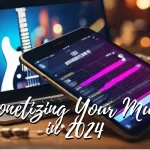Navigating Music Copyright and Licensing: Protecting Your Work
In the vibrant world of music creation, understanding copyright laws and licensing principles is paramount for artists, composers, producers, and music industry professionals. Music copyright and licensing not only protect creators’ intellectual property but also facilitate legal use, distribution, and monetization of musical works. In this comprehensive guide, we will delve into the fundamentals of music copyright, types of licenses, licensing platforms, and strategies for navigating the complex yet crucial terrain of music copyright and licensing.
Understanding Music Copyright
What is Copyright?
Copyright is a legal framework that grants creators exclusive rights to their original works, including musical compositions, lyrics, recordings, and arrangements. It protects against unauthorized use, reproduction, distribution, public performance, and adaptation of copyrighted works.
Ownership of Copyright:
In most jurisdictions, the creator or author of a musical work automatically owns the copyright upon creation. For collaborative works, copyright may be shared among contributors based on their respective contributions, unless otherwise agreed upon in writing.
Duration of Copyright:
Copyright protection typically lasts for the lifetime of the creator plus a specified number of years after their death (e.g., 70 years in many countries). After the copyright term expires, works enter the public domain and can be freely used by anyone.
Types of Music Copyright
Musical Compositions:
Copyright protects the musical composition itself, including melodies, harmonies, lyrics, and arrangements. It is represented by the copyright symbol © and covers both notated scores and recorded versions of the composition.
Sound Recordings:
Separate copyright exists for sound recordings, which refer to the actual recorded performance of a musical work. This copyright is represented by the symbol ℗ (phonogram copyright) and covers the specific audio recording, distinct from the underlying composition.
Music Licensing Basics
What is Music Licensing?
Music licensing involves granting permission to use copyrighted music in various contexts such as public performances, recordings, synchronization with visual media (films, TV shows, ads), digital streaming, and more.
Types of Licenses:
- Performance Rights License: Required for public performances of music, including concerts, broadcasts, live venues, and online streaming. Organizations like ASCAP, BMI, and SESAC manage performance rights and collect royalties for songwriters and publishers.
- Mechanical License: Needed for reproducing and distributing recorded music (e.g., CDs, digital downloads). Mechanical royalties are paid to songwriters, composers, and publishers for each copy or download.
- Sync License: Authorizes the synchronization of music with visual media such as films, TV shows, commercials, video games, and online videos. Sync licenses involve negotiation with rights holders for specific usage rights and fees.
- Master Use License: Grants permission to use a specific sound recording in audiovisual projects, remixes, covers, and sampled works. It requires clearance from both the sound recording owner (record label or artist) and the composition owner (songwriter or publisher).
Navigating Music Licensing Platforms
Music Libraries and Agencies:
Online music licensing platforms such as Epidemic Sound, AudioJungle, Pond5, and Musicbed offer a curated catalog of royalty-free music for various projects. Artists can license their music to these platforms for exposure and revenue opportunities.
Rights Management Organizations:
Collaborate with music rights organizations (PROs) like ASCAP, BMI, SOCAN, PRS, and others to manage performance rights, collect royalties, and access licensing opportunities globally. PROs also offer educational resources, networking events, and advocacy for music creators.
Digital Distribution Platforms:
Distribute music through digital aggregators like TuneCore, DistroKid, CD Baby, and Symphonic Distribution to reach global streaming platforms, download stores, and licensing opportunities. These platforms handle licensing, royalties, and distribution logistics for artists.
Strategies for Protecting Your Music
Register Copyright:
Register your musical compositions and sound recordings with copyright offices (e.g., U.S. Copyright Office) to establish legal ownership and eligibility for statutory damages in case of infringement.
Use Contracts:
When collaborating with musicians, producers, labels, and licensing partners, use clear contracts outlining rights, royalties, usage terms, and termination clauses to protect your interests and avoid disputes.
Watermark and Metadata:
Embed metadata, ISRC codes, and ownership information in your music files to track usage, prevent unauthorized sharing, and facilitate licensing and royalties tracking.
Monitor and Enforce:
Regularly monitor digital platforms, streaming services, social media, and websites for unauthorized use or copyright infringement of your music. Take prompt action through takedown requests, cease-and-desist notices, and legal recourse when necessary.
Educating Yourself and Seeking Guidance
Stay Informed:
Keep abreast of copyright laws, licensing trends, industry developments, and best practices through industry publications, workshops, seminars, and online resources.
Consult Legal and Industry Experts:
Seek advice from entertainment lawyers, music business consultants, rights management professionals, and industry organizations for tailored guidance on copyright protection, licensing strategies, negotiations, and contractual matters.
Navigating Music Copyright and Licensing: Protecting Your Work
In addition to the fundamental aspects of music copyright and licensing, there are nuanced strategies and considerations that music creators should be aware of to maximize protection and revenue opportunities.
Emerging Trends and Challenges
- Digital Rights Management (DRM): Explore digital rights management tools and services that offer content protection, encryption, and monitoring to prevent unauthorized sharing, piracy, and distribution of your music across online platforms, social media, and peer-to-peer networks.
- Blockchain Technology: Investigate blockchain-based platforms and smart contracts for transparent, decentralized music rights management, royalty distribution, and tracking of music usage, ensuring fair compensation and attribution for creators in a digital ecosystem.
- International Copyright Compliance: Understand international copyright laws, treaties (such as the Berne Convention), and reciprocal agreements between countries to protect your music rights globally, navigate cross-border licensing, and collect royalties from international usage.
Collaborations and Clearances
- Sample Clearances: When using samples, loops, or excerpts from copyrighted works in your music productions, obtain proper sample clearances, licenses, or use royalty-free samples to avoid copyright infringement claims and legal repercussions.
- Collaborative Projects: Establish clear agreements, split sheets, and licensing terms with collaborators, featured artists, producers, and songwriters to define ownership rights, revenue shares, and usage permissions for collaborative music projects.
Marketing and Monetization Strategies
Sync Licensing Agencies: Collaborate with music sync licensing agencies, music supervisors, and sync agents specializing in placing music in films, TV shows, ads, and multimedia projects. Tailor your music portfolio, create instrumental versions, stems, and alternate mixes for diverse licensing opportunities.
Direct-to-Fan Sales: Leverage direct-to-fan platforms such as Bandcamp, Patreon, and fan subscription services to sell music, exclusive content, merchandise bundles, and experiences directly to your fan base, fostering deeper connections and sustainable revenue streams outside traditional channels.
Education and Advocacy
Music Copyright Education: Educate yourself and your team about copyright basics, fair use principles, public domain works, Creative Commons licenses, and emerging copyright legislation (such as the Digital Millennium Copyright Act) to make informed decisions and protect your rights in the digital age.
Advocacy and Industry Collaboration: Support advocacy efforts, industry organizations (like the Recording Academy, Music Publishers Association, and Independent Music Companies Association), and lobbying initiatives that promote fair compensation, transparent royalties, and creators’ rights in the music ecosystem.
Conclusion: Empowering Music Creators in a Complex Landscape
Navigating music copyright and licensing requires a blend of legal knowledge, strategic planning, industry insights, and creative vision. By understanding the fundamentals of copyright, exploring diverse licensing opportunities, leveraging digital platforms, protecting intellectual property, and seeking professional guidance when needed, music creators empower themselves to protect their work, monetize their talent, and thrive in the dynamic music industry ecosystem. Embracing innovation, collaboration, and continuous learning fosters a sustainable and rewarding journey for musicians, composers, and music professionals, ensuring that their artistic contributions are valued, protected, and appreciated by audiences worldwide.


